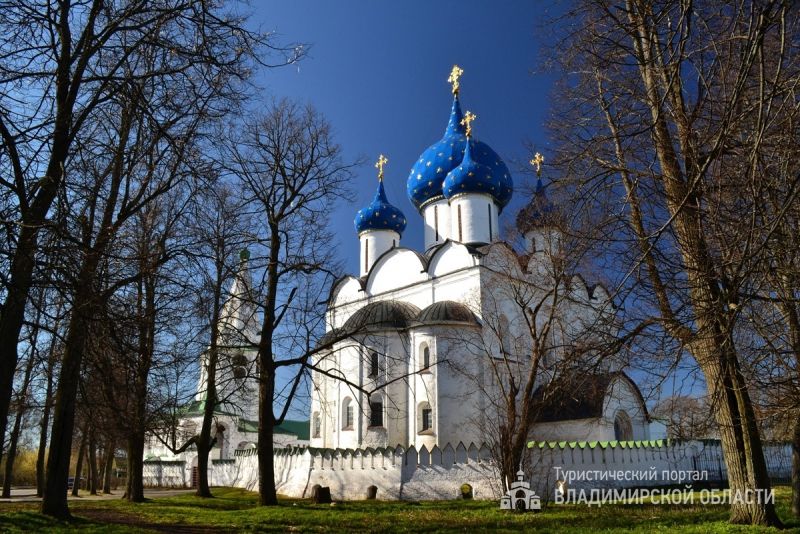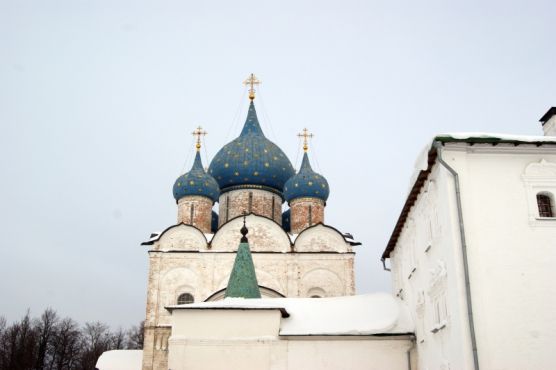Suzdal Kremlin. Nativity Cathedral
At the turn of the 11th-12th centuries, Vladimir Monomakh built a fortress of Suzdal – the Kremlin, a fortified place in the bend of the Kamenka River. From the west, the river became a natural barrier, and from the eastern flat side, a moat was dug out (up to 30 m wide, up to 9 m deep). The fortress was surrounded by embankment earthen ramparts (with a common perimeter up to 1400 m) with wooden walls stretching along their ridge. The Kremlin ramparts and moat are now well preserved and are the most ancient sights of Suzdal.
Simultaneously with the construction of the fortress, a large (six-pillar) one-domed Assumption Cathedral was erected here by the masters brought by Vladimir Monomakh from Kiev. It was built of thin brick-plinth. The inner walls and vaults were painted by the best Byzantine artists. However, in spite of the constant concern of the authorities for its preservation, it constantly collapsed (apparently, this was facilitated by a shallow foundation – only 55-60 cm). Therefore, in 1148 Yury Dolgoruky ordered to dismantle the cathedral and build on this place a new one, from porous limestone, which can be easily processed. Three drums with helmet domes gave the temple a special expressiveness.
In 1222, by order of Prince George Vsevolodovich, raised on the decorative wealth of the Cathedral of St. Demetrius in Vladimir, the upper part of the former cathedral of Yury Dolgoruky was dismantled. And three years later (1225) in its place was erected, in fact, a new white-stone temple in honor of the Nativity of the Virgin. Decorated with reliefs, according to annalistic evidence, it was even more beautiful than the ancient cathedral.
The new Nativity Cathedral differed from its predecessor by a powerful foundation, the upper part of which was hidden by an artificial hill. But there were some differences in the temple from its white-stone contemporaries. The walls from the inside had a layer of brick-plinth, and were faced on both sides with uneven slabs of porous tuff. Only architectural details with embossed ornaments were made of the more expensive hewn white stone: arched-columnar frieze, carved portals, half-columns of altar apses. The rich decoration of the facades has lost its connection with the logic of the internal construction of the building (for example, the columnar belt is placed without regard to the level of the choir, etc.), which also distinguished the Nativity Cathedral from the architectural tradition of the Vladimir white-stone temples.
However, this new cathedral did not reach us in its original form. After the fire of 1445, its top collapsed. Therefore in 1528-30 years, its walls were dismantled to a columnar belt and completed with bricks. The Nativity Cathedral became five-domed. In the 17th-19th centuries, the building underwent further alterations (slat-like windows were rasterized, huge bulbous heads were made, the covering in accordance with the zakomaras was replaced by a four-pitched roof, from the north and west the temple was surrounded by brick extensions, the facades were painted in a dirty red color, etc.). In the years 1954-55, the cathedral was liberated from later buildings, restored by A.D. Varganov and I.A. Stoletov, having acquired a modern look. Survived since the 13th century, the lower tier of the temple allowed to compose an idea of the ancient monument in general.
The Nativiny Cathedral was distinguished by the fact that its architecture was closely connected with its close location to the northern wall of the fortress (on the site defined by the Monomakh cathedral) and the surrounding area of the Kremlin. Respectively, the facades were treated differently. The architects paid special attention to the rich carved decoration of the front southern facade and the portal, through which the townspeople went to the temple from the side of the square. The second most important, apparently, was the western facade and the stately carved portal facing the prince's house. The northern facade facing the shaft was much poorer, judging by the monotony of the carving, less experienced craftsmen trimmed it.
After seven years of restoration work in 2005, the exposition of the Nativity Cathedral was opened to visit, on which one can judge the rich interior of the ancient temple. It impresses with many rare monuments of decorative and applied art and ancient Russian painting of the 13th-17th centuries.
The Golden Gates, decorating the southern and western portals of the cathedral, are especially distinguished. Created by ancient masters in the 1230s, the gates were like a gigantic golden icon. On the blackened copper plates of the western gates the golden pattern depicts evangelical plots, in the center of which is the Virgin, as the patroness of the Vladimir land. In particular, on the gates there is one of the oldest images of the holiday of the Intercession, established in Vladimir. The southern gates are painted with the stories of the Old Testament with the deeds of Archangel Michael. Lion masks holding massive rings in the mouth served as door handles. On the lower hallmarks of the gates leopards and mythical griffins are depicted, which seemed to have come down from the Vladimir-Suzdal white-stone reliefs.
Valuable art monuments of the 17th century in the cathedral are: the Royal Gates of the iconostasis (the large double doors of the altar and the deacon), three small lamps and one large lamp in the form of a five-domed church, large crosses adorned with gilded silver, as well as two icons depicting Jesus Christ and the Mother of God from the "local" series of the iconostasis of the cathedral.
In 1991, solemn divine services resumed in the Nativity Cathedral. In February 1992, between the Vladimir-Suzdal Museum-Reserve and the Diocese, an agreement was signed on the joint use of the cathedral. On September 10, 1995 the solemn service in the cathedral was performed by the Patriarch of All Russia Alexy II.
The Nativity Cathedral of the 13th century – the oldest of the monuments of architecture preserved in Suzdal – was included in the UNESCO World Heritage List in 1992.
 Tourism portal of the
Tourism portal of the

